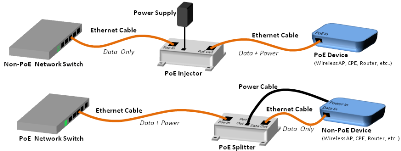The evolving standards of PoE
(blogger@L-com.com)
The IEEE standards for providing PoE have been around for almost a decade now, but the actual technology to accomplish this is even older. The original concept was pretty simple: Category 5 cabling has eight conductors, but the standard really only used four of them. The low-voltage power could be run along the unused conductors to provide enough power for most simple devices. Through the use of an "injector" at one end and a "tap" at the other end, the power could travel along without noticeable problems with the data. Within a few years, manufacturers of many different types of IP equipment began implementing designs that would accept power directly from the cable, eliminating the need for a "tap". Next, manufacturers of the Ethernet switching equipment developed PoE Injector Hubs to directly inject the power into the cable, eliminating the need for an "injector". But there were three big problems:
- Adoption of PoE wasn't universal, meaning there was a lot of equipment that still required power and did not accept PoE directly
- Different manufacturers were doing PoE in different ways, requiring both the power sourcing equipment to match the method used by the remote powered equipment
- While 10Base-T and 100Base-T speeds did not use all eight conductors in the Ethernet cable, 1000Base-T (and beyond) does require all conductors
The first problem is being addressed over time, but for now you can still use PoE on just about anything so long as you have a separate device to inject or tap the power from the cable. Since these devices occur in the middle of the span of the cable, they are often collectively called midspans. PoE midspans are widely available and often provide a lot of useful features, such as lightning and surge protection, easy methods to install or mount the device, and multiple ports in a single device to simplify the setup.
In 2003 the IEEE came out with standard IEEE 802.3af, designed to fix the second problem. Nowadays, if you buy a piece of equipment that is PoE ready, you must make sure that it supports the IEEE standard pinout and power requirements. If it does not, you may not be able to use the PoE features with all midspans or switches or risk damaging it. Some midspans and switches auto-detect the PoE method to prevent this.
The third problem was fixed in 2009 with the IEEE 802.3at standard, sometimes called PoE plus. It uses a technique called phantom power, which had been used in telephones for decades, to run both data and power on the same pairs. In addition, the new standard provides better power management and larger max power available to the equipment at the end.
Applications for PoE
You may not know it, but PoE may be in use all around where you work. In addition to the use in security cameras, which are ever more prevalent today, PoE is common in VoIP phones and equipment, networking equipment, intercom and other public address or "paging" systems, remote sensors, and wireless access points. In fact, PoE is even used in things like lighting, emergency buttons (used to signal a problem on a production line, for instance), kiosks in stores to process payments, door access and keycard devices, RFID, and lots more.
Today, through the use of midspans, virtually any small piece of IP equipment can be powered without direct access to an AC line. Newer midspans are becoming smaller, or are integrating the power supply module into the same housing, allowing PoE products to be installed in very tight spaces like weatherproof enclosures.
Quick note: L-com has a full line of PoE products to help utilize this advanced technology in your remote installations. Visit the L-com PoE Product Center to also see a helpful diagram of the four most common PoE setups, or download the free whitepaper that explains all of the details of PoE you could ever want.

No comments:
Post a Comment